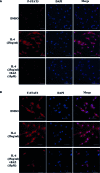Bazedoxifene Attenuates Abdominal Aortic Aneurysm Formation via Downregulation of Interleukin-6/Glycoprotein 130/Signal Transducer and Activator of Transcription 3 Signaling Pathway in Apolipoprotein E-Knockout Mice
- PMID: 32362823
- PMCID: PMC7180191
- DOI: 10.3389/fphar.2020.00392
Bazedoxifene Attenuates Abdominal Aortic Aneurysm Formation via Downregulation of Interleukin-6/Glycoprotein 130/Signal Transducer and Activator of Transcription 3 Signaling Pathway in Apolipoprotein E-Knockout Mice
Abstract
Abdominal aortic aneurysm (AAA) is a chronic inflammatory disease characterized by aortic dilatation and predominantly affects an elderly population. Accumulating evidence suggests that Interleukin-6 (IL-6) and the signal transducer and activator of transcription 3 (STAT3) play an important role in formation of AAAs. However, it remains unclear whether Bazedoxifene (BAZ) could suppress the activation of IL-6/GP130/STAT3 in vascular cells and the formation of AAA. Here we explored the effect of BAZ on AngII-stimulated AAA formation. ApoE-/- mice infused with AngII for 28 days using osmotic minipumps were treated with placebo or 5mg/kg BAZ. In our results most of the AngII-induced mice developed AAA with exacerbated inflammation, degradation of elastin fibers, STAT3 phosphorylation, and increased expression of matrix metalloproteinases (MMPs). These effects were markedly attenuated by BAZ. Furthermore, BAZ suppressed the stimuli-induced (IL-6 or AngII) expression of P-STAT3, MMP2 and MMP9 in vascular smooth muscle cells (VSMCs). BAZ inhibited wound healing, colony formation and suppressed STAT3 nuclear translocation in vitro. In conclusion, these results indicated that BAZ downregulated IL-6/GP130/STAT3 signaling and interfered with AAA formation induced by AngII in ApoE-/- mice, which indicates a novel potential strategy for the prevention and therapy of AAA.
Keywords: IL-6; STAT3; abdominal aortic aneurysm; bazedoxifene; inflammation.
Copyright © 2020 Yan, Ma, Shi, Luo, Liu, Guo, Zhai, Tao, Huo, Li, Lin, Li, Lv, Zhang and Lin.
Figures






References
-
- Argyriou C., Georgiadis G. S., Kontopodis N., Pherwani A. D., Van Herwaarden J. A., Hazenberg C., et al. (2018). Screening for Abdominal Aortic Aneurysm During Transthoracic Echocardiography: A Systematic Review and Meta-analysis. Eur. J. Vasc. Endovasc Surg. 55 (4), 475–491. 10.1016/j.ejvs.2018.01.003 - DOI - PubMed
-
- Butoi E., Gan A. M., Tucureanu M. M., Stan D., Macarie R. D., Constantinescu C., et al. (2016). Cross-talk between macrophages and smooth muscle cells impairs collagen and metalloprotease synthesis and promotes angiogenesis. Biochim. Biophys. Acta 1863 (7 Pt A), 1568–1578. 10.1016/j.bbamcr.2016.04.001 - DOI - PubMed
LinkOut - more resources
Full Text Sources
Miscellaneous

